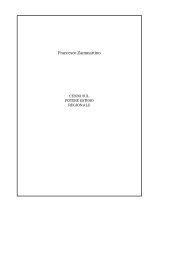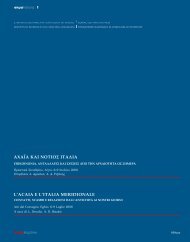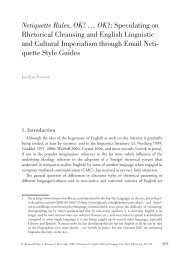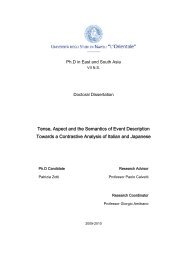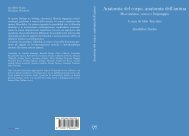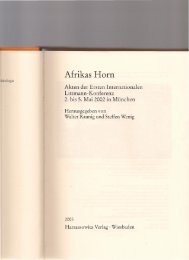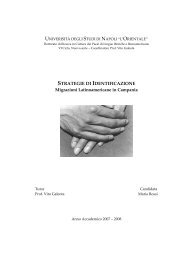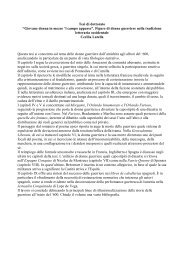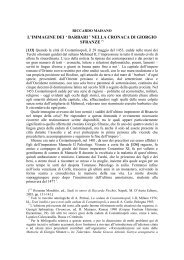Leonardo da Vinci. L'“angeLo incarnato” - OPAR L'Orientale Open ...
Leonardo da Vinci. L'“angeLo incarnato” - OPAR L'Orientale Open ...
Leonardo da Vinci. L'“angeLo incarnato” - OPAR L'Orientale Open ...
Create successful ePaper yourself
Turn your PDF publications into a flip-book with our unique Google optimized e-Paper software.
ay the Portuguese could refill the ships, visit the neighboring<br />
localities, and, because of the security of the landing conditions<br />
and the cordiality of the inhabitants, call the place Bom Bahia,<br />
the ‘good bay’, then in English Bombay, and in Hindi Mumbai.<br />
One of the most easily reachable and defen<strong>da</strong>ble places was just<br />
the small island of Garapur; and on that occasion it could have<br />
been the first stop in the visit of the site. News about it could<br />
have spread only afterwards to reach Europe. Hence the existence<br />
made known of an extraordinary temple, excavated in the<br />
rock of the mountain about the sixth and seventh century A.D.,<br />
and dedicated to the worship of Shiva, a deep cave with three<br />
openings and entry-porchs, crossed by five equal naves, sustained<br />
by colossal pillars also cut out of the rock 19 . On the right,<br />
after the entrance, there is a square shrine sacred to the adoration<br />
of the divine Lingam; in the inner and <strong>da</strong>rker part of the<br />
cave, three ‘chapels’ with enormous relieves of Shiva. The most<br />
amazing detail, also in modern archeological plans (such as the<br />
classical map by the British scholar James Burgess), is the perfection<br />
of the ‘plan’ of the santuary, and this in spite of the difficulty<br />
of digging a space so large in the rock of the mountain: a<br />
perfect square, composed of four sides, each of which is made of<br />
five smaller squares. This is actually the “map of Ellefante” that<br />
<strong>Leonardo</strong> could have seen: a ‘map’ that could have had a deep<br />
suggestion in whom, like <strong>Leonardo</strong>, was often involved in architectural<br />
projects based on a central plan (for example, in Ms. B),<br />
and when the interest in central plans for the big religious buildings<br />
was very high, from the Sangallos to Bramante, all the way<br />
to the colossal project of the new basilica of Saint Peter in Rome.<br />
When could the ‘map of Ellefante’ have come to Italy? Unlikely<br />
before 1509, the year of the ‘discovering’ of the Bom Bahia by<br />
the Portuguese. The note in Ms. F is likely later of some years<br />
after the <strong>da</strong>tes present in the manuscript (1508) 20 ; and the most<br />
probable period could have been after the arrival of <strong>Leonardo</strong> in<br />
19<br />
On Elephanta: R. Gough, A Comparative View of the Ancient Monuments of India, Particularly<br />
those in the Island of Salset near Bombay, London, 1785 ; J. Burgess, The Rock-Temples<br />
of Elephanta or Ghârâpurî, Bombay, D.H. Sykes, Times of India Office, 1871 (I ed. 1855); J.<br />
Fergusson - J. Burgess, The Cave Temples of India, London, Allen-Trübner-Stanford-Griggs,<br />
1880, pp. 465; H. Sastri, A Guide to Elephanta, Delhi, Manager of publications, 1934; W. D.A.O.<br />
O’Flaherty, Elephanta. The Cave of Shiva, Princeton, 1983; O.C. Kail, Elephanta, Bombay,<br />
1984; C. Berkson, Elephanta: The Cave of Shiva, Delhi, Motilal Banarsi<strong>da</strong>ss Publ., 1999. On<br />
the worship of Shiva: C.D. Collins, The Iconography and Ritual of Śiva at Elephanta, New<br />
York, 1988.<br />
20<br />
Carlo Pedretti notes that the writing of <strong>Leonardo</strong> leaves a blank space between “dindia”<br />
and “chella”, beacause of the impression of a stain in the opposite page (f. 96v), whose first<br />
lines, of medical subject, would therefore be earlier. And also the ‘Indian’ note presents a<br />
stain, that leaves its impression on f. 96 v.<br />
Rome (Fall 1513). It is in fact Rome the milieu of the pope Leone<br />
X and his brother the magnificent Giuliano de’ Medici. As one<br />
of the main centers in Europe, the news about oceanic navigations<br />
(and particularly Portuguese) were collected and spread<br />
elsewhere. Among the most important fund-raisers of Portuguese<br />
enterprises there were the Florentine merchants and bankers in<br />
Lisbon, Bartolomeo Marchionni and Girolamo Sernigi, whose<br />
familiars or associates or depen<strong>da</strong>nts are often directly involved<br />
in the journeys, as commanders of ships of the fleet, or even appointed<br />
feitores, governors of the newly conquered territories in<br />
India and in South-East Asia 21 .<br />
In Rome was also Corsali before his departure to India, charged<br />
in 1514 of the singular mission (anyway not carried out) of delivering<br />
a Latin letter of the pope (written by Pietro Bembo) to the<br />
King of Ethiops Lebna Dengel. And from Rome instructions were<br />
sent to the papal nuncios in European courts, as Antonio Pucci<br />
in Lisbon, who was to meet in the same year 1514 Giovanni <strong>da</strong><br />
Empoli, just back from his second journey (1510-1514) with the fleet<br />
of Diogo Mendes de Vasconcelos. Giovanni had then participated<br />
to the bloody conquest of Goa (November 1510), and had traveled<br />
from Cambaia to Malabar, with a possible visit to the island of<br />
Elephanta 22 . Afterwards he would have left in 1515 towards India<br />
with a relative of the nuncio, Benedetto Pucci, and could have<br />
met in Cochin Corsali and other Florentine travelers residents<br />
between Goa and Cochin: Lionardo Nardi, Piero di Giovanni<br />
di Dino, Piero Strozzi, Francesco Corbinelli. Unfortunately, the<br />
name of the merchant Antonello, who supposedly owned a map<br />
of Ellefante, doesn’t appear in letters and reports by Florentine<br />
merchants and in contemporary chronicles; nothing but a hint in<br />
a letter by Piero Rondinelli, at the time of the first trip by Vasco<br />
de Gama (Sevilla, October 3, 1502): “Antonio the Italian remains<br />
longer there, by Calicut, in a place called Cananor, because he<br />
couldn’t sell his marchandises” 23 .<br />
That is all it could be said about the “map of Ellefante”. But<br />
there is still a detail not enough enlightened. What was there (and<br />
21<br />
See, besides his important studies already quoted, M. Spallanzani, Florentine Merchants in<br />
India in the Sixteenth Century, in A Mirror of Princes. The Mughals and the Medici, ed. D. Jones,<br />
Bombay, 1987, pp. 107-112.<br />
22<br />
Spallanzani, Mercanti fiorentini, pp. 32-34. See also note 8, supra.<br />
23<br />
The letter is in Codice Vaglienti (Florence, Bibl. Riccardiana, 1910), f. 56 r, an important<br />
collection of notices and letters about the journeys outside Europe at the beginning of the<br />
sixteenth century, particularly towards India (see Iddio ci dia buon viaggio e gua<strong>da</strong>gno. Firenze,<br />
Biblioteca Riccardiana, ms. 1910 (Codice Vaglienti), Ed. crit. a c. di L. Formisano, Florence, 2006,<br />
p. 126).<br />
“Ma p o f El e p h a n ta in In d i a”<br />
373



